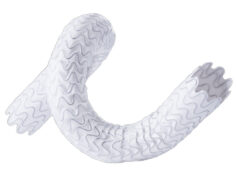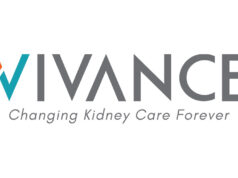
In a Podium First presentation during the vascular access masterclass at Charing Cross (CX) Symposium 2023 (25–27 April, London, UK), Frans Moll (University Medical Center Utrecht, Utrecht, Netherlands) provided the audience with an update on the novel Axess graft (Xeltis), which is intended to improve haemodialysis access outcomes via endogenous tissue restoration (ETR).
“This graft can bring a brighter future for the increasing number of patients who depend on dialysis treatments,” Moll told Renal Interventions. “And, I think we could see this in the next two-to-three years—the study is running, patients are actively being enrolled, and we are seeing very positive outcomes. We always have to be modest, but we are certainly optimistic about this.”
Initially, the speaker highlighted the goal of this device—to provide an implantable polymer-based technology that harnesses the body’s natural ability to regenerate cells. The Axess graft utilises supramolecular chemistry and precise electrospinning, offering the basis for a tuneable medical device that can act as a scaffold and allow the body to effectively create its own vessel.
Following implantation, ETR enables the graft to gradually be absorbed by the body, resulting in a ‘natural, living’ graft akin to an autologous arteriovenous fistula (AVF). Moll also noted that the proprietary technology behind Axess can be ‘coded’ during the manufacturing process, enabling absorption times to be adjusted.
The goal here—according to Moll—is to combine the early-stage benefits of an arteriovenous graft (AVG), including the possibility for early cannulation and no maturation requirement, with the more long-term advantages associated with AVFs, such as improved patency rates, and a reduced number of interventions and infections over time.
Moving on to outline the latest data with Axess from an EU first-in-human (FIH) study, Moll detailed that enrolment of a total of 20 patients across six sites has now been completed. As per follow-up data, which were available for all 20 patients, primary patency rates of 80% at six months and secondary patency rates of 100% at 12 months were achieved. The speaker also reported that no infections were observed. A full follow-up period of five years is now planned in these patients, and is ongoing.
Moll also provided attendees with insight based on surgeon feedback from the first 20 Axess implants—alluding to the fact it is a similar procedure to standard AVG implantation; the device being easier to suture and softer than traditional expanded polytetrafluoroethylene (ePTFE) products; and its improved adaptation to patient arteriotomy/venotomy proving “very helpful” in fragile vessels.
A prospective, single-arm EU pivotal trial of Axess is now also actively enrolling patients, at up to 25 sites spanning nine countries and with a total follow-up period of five years. Moll noted that enrolment in this larger-scale study began in Q4 2022. Among the key study endpoints is freedom from device-related serious adverse events during the first six months after implantation, and the pivotal trial is also powered to assess both primary and secondary patency rates.












